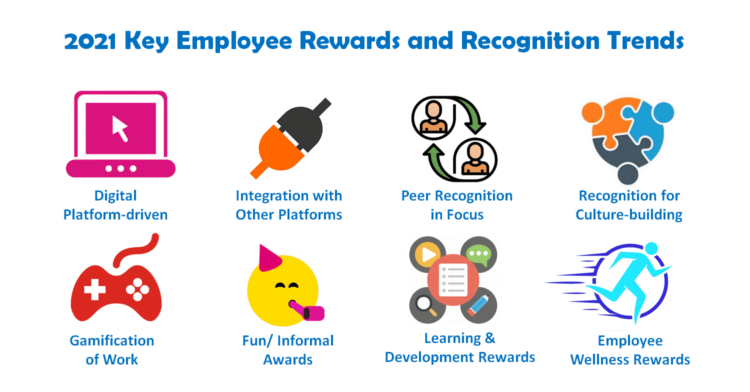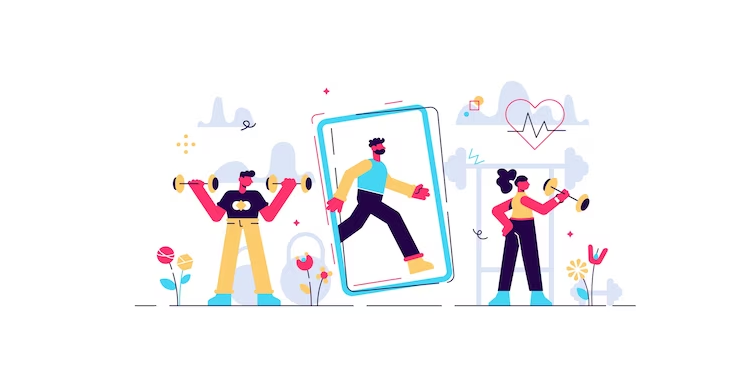1. Digital and platform-driven recognition will become essential, with organizations investing in integrated tools that align employee recognition with business goals and enhance remote and digital work environments.
2. There will be an increased focus on peer recognition and culture-building, using recognition to foster collaboration, align behaviors with core values, and build a positive work culture.
3. Gamification and informal awards will enhance employee engagement and motivation, making recognition programs more interactive, fun, and relevant in remote work.
4. Rewards for learning, development, and wellness activities will encourage employee growth, skill enhancement, and well-being, contributing to productivity and retention.
2020 was a year that pushed organizations to adopt new operating models and underscore the importance of the digital workplace as part of the operating strategy. Employee rewards and recognition, too, are likely to see significant changes. Look at the critical employee rewards and recognition trends in 2021 and beyond.
Also, read about the Key Trends in Employee Recognition in 2022

Overall, 2020 was tumultuous for almost every organization, regardless of size and industry segment.
As a result, organizations were forced to adopt new methods of working and how they keep their workforce engaged and motivated.
Here are the key factors that will impact employee rewards and recognition in 2021:

The COVID-19 pandemic forced most organizations to switch to the digital working mode.
Though organizations had previously invested in digital tools, the pandemic has helped accelerate their usage.
On the other hand, organizations that have been slow to adopt these tools have started embracing them faster.
The large-scale adoption of the digital workplace is going to make a significant impact on employee rewards and recognition practices.
Organizations must also modify their policies and practices to adapt to the needs and challenges of a changing work environment.

The health crisis caused by the pandemic has made organizations more focused on the health and well-being of employees.
Hence, organizations have started focusing on the holistic wellness of employees to ensure productivity and retention. This includes physical, mental, and psychological well-being.
Hence, organizations need to evolve their employee rewards and recognition policies to drive wellness initiatives.

In 2020, the need to stay connected and continuously communicate with employees is greater than ever.
With most employees working in isolation, the fear of being left out increases their stress levels.
That is why organizations should ensure that their rewards and recognition programs create a sense of inclusion among the employees.
They can do this by acknowledging and appreciating their efforts promptly and appropriately.

Also, the pandemic has triggered large-scale job losses and pay cuts across organizations.
This, coupled with the growing isolation of working remotely, can breed employee disengagement.
Finally, this might result in attrition as the economic growth picks up and the job market opens up.
Hence, organizations need to drive higher engagement through their reward and recognition programs and create greater confidence and loyalty toward the organization.
The outbreak of the pandemic in 2020 is driving large-scale and permanent changes in the way organizations operate.
Organizations need to realign their rewards and recognition programs to ensure that their employees feel accepted, included, and appreciated, no matter whether they are working from home or office.
Here’s a look at the key trends in employee rewards and recognition in 2021:
1. Digital and Platform-driven
2. Integrated with Other Digital Platforms
3. Focus on Peer Recognition
4. Recognition for Culture-building
5. Gamification of Work
6. Informal or Fun Awards for Engagement
7. Rewards for Learning and Development Activities
8. Rewards for Employee Wellness


Most organizations plan to have a significant segment of their workforce operating from home in 2021,
Hence, it is unsurprising that organizations will invest heavily in technology platforms for employee recognition.
These recognition platforms will enable organizations to deliver digital programs that can cater to the needs of a virtual and distributed workforce in terms of timeliness, frequency, and social visibility, with minimal administrative overheads.
Hence, organizations must choose end-to-end recognition platforms that can help digitize and automate their programs, are cost-effective, simple to manage, and ensure a high level of end-user experience for the employees.
Take a look at the Features and Functionalities of the HiFives Platform

In 2021, recognition platforms will rarely operate independently but will integrate with other digital platforms and work tools.
Therefore, this will ensure a better alignment of employee recognition with the business goals and drive higher productivity.
Integration of employee recognition platforms is likely to happen with platforms such as HRMS, work collaboration tools (like Slack and Teams), customer management systems, and learning management systems.
This will create a seamless employee experience while driving better business results.
Take a look at 3rd Party Integration Options of the HiFives Platform

Peer-to-peer recognition has already become recognized as one of the most effective ways of appreciating employees’ excellent work and keeping them motivated.
In 2021, peer recognition will move into the mainstream of employee recognition as organizations will look at it as an effective way to drive collaboration among remote-working employees, and create a positive work culture.
Read about Peer-to-Peer Recognition – Understanding the Nuts and Bolts

Without other levers in a physical work environment, employee recognition will be essential in creating a positive work culture in 2021.
Hence, supervisors and peers should be encouraged to recognize behaviors that are in alignment with the organization’s core values and help in building a great work environment.
Read about How the Employee Recognition Program can drive Cultural Change

Organizations are likely to use gamification of work to motivate employees and address the challenges of working remotely.
Digital recognition platforms will enable organizations to implement gamification practices such as challenges, contests, reward points, and digital leaderboards.
This will increase employee participation and interest in the recognition programs, making them more fun and exciting.
Read about Gamification as a means of Enhancing Employee Engagement

With many critical levers of employee engagement unavailable in the digital workplace, organizations can look at informal or fun awards to drive greater engagement among remote-working employees.
Hence, these fun awards could be given for appreciating positive attributes, interests, and hobbies of co-workers; ranging from sports, adventure, fitness, music, fashion, food, gaming, gadgets, etc.
These can be implemented through an online nomination and polling process.
Informal or fun rewards can break the monotony of working alone, create more excellent bonding between team members, and foster a positive work environment.
Read about Informal or Fun Awards for Employee Engagement

Organizations looking to invest in learning and development to upgrade employee skills to stay competitive must ensure high employee interest and participation.
Rewarding employees for learning and development activities can ensure that employees are motivated to put in their best efforts to learn and upgrade their skills, which are important to the organization in the long run.
Read about How Learning and Development can promote Employee Engagement

Also, as organizations focus on employee wellness initiatives to keep their employees healthy, motivated, and productive, wellness rewards will likely become essential for driving participation and interest in such activities.
Hence, the organization should reward employees for improving awareness, participating in various wellness activities, and encouraging healthy competition between co-workers.
This could be achieved by integrating various fitness devices used by the employees, displaying individual and group performance through digital leaderboards, creating challenges and contests, and rewarding winners with reward points.
Read about Employee Wellness Ideas for Work from Home
Understanding the key employee rewards and recognition trends in 2021 and beyond can help organizations put in place the right policies, processes, and systems to develop a highly motivated and committed workforce going forward.
Organizations that do so can reap business benefits in the short and long run.

Lead author: Sagar Chaudhuri, the Co-Founder and CEO of HiFives. He is an HR Tech Evangelist with over 25 years of corporate and entrepreneurship experience. In the past, Sagar has worked in leadership roles with companies such as Genpact, Infosys, and ICICI Bank. He has an engineering degree from IIT Kharagpur and an MBA from IIM Lucknow. Connect on LinkedIn
To stay updated on the latest HiFives blogs, follow us on Twitter (@MyHiFives)